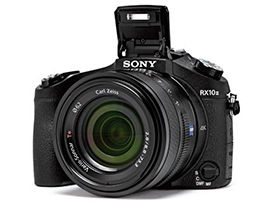 With professional videos becoming part of compact cameras, traditional video equipment manufacturers have become the strongest players even in still imaging, especially in the mirrorless category. With their expertise in videos, Sony and Panasonic have reincarnated as leaders in the mirrorless space.
With professional videos becoming part of compact cameras, traditional video equipment manufacturers have become the strongest players even in still imaging, especially in the mirrorless category. With their expertise in videos, Sony and Panasonic have reincarnated as leaders in the mirrorless space.
The Sony RX10 II (also known as RX10 M2) is an improved version of the RX10, which received thumbs up from the compact market for its excellent performance. The RX10 II adds advanced 4K recording and a slew of high-speed imaging features apart from improvements in imaging quality.
Design and Build Quality
Th e Sony RX10 II is designed and built identical to the RX10. The camera is built around a magnesium alloy chassis with addition of engineering plastics on the outer shell, making it a light, yet sturdy camera. Th e camera is dust and moisture resistant. It sports a D-SLR-like look with a lens that is bulkier than those usually seen in compact cameras. This is understandably because of the constant f/2.8 that it provides. Th e lens has a manual aperture ring that has physical stops at every 1/3 EV. Th e camera has a deep grip with textured rubber finish. Th e tripod receptacle is metal. At 813g, the RX10 II is quite light.
Key Features
The 20.2 megapixel Sony RX10 II uses a 1.0-inch Type Exmor RS Stacked CMOS sensor (13.2 x 8.8mm), along with the latest BIONZ X image processor to deliver more efficient image reproduction than its predecessor. The sensor unit has a DRAM chip attached, which helps the camera to perform high-speed imaging without the buff er overfl owing. The camera uses a Carl Zeiss Vario-Sonnar T* 24-200mm equivalent lens providing a constant maximum aperture of f/2.8 throughout the zoom range. It provides a minimum aperture of f/16. The lens is constructed with 14 elements in 11 groups including 7 aspheric elements including an Advanced Aspherical (AA) element. The lens features optical SteadyShot Image Stabilisation in addition to electronic compensation, which can be activated in Movie mode. The advanced Image Stabilisation also compensates for rolling shutter effect in movie mode. The camera also features clear image zoom, which crops the image and interpolates it without significant loss in detail. Clear image zoom offers an additional 2x magnifi cation at 20 megapixels and 2.8x at 10 megapixels.
The lens focusses from approximately 13cm to infi nity at the wide-angle end and from approximately 39cm to infi nity at the telephoto end. Focus modes available are Direct Manual Focus, Manual Focus, Single-shot AF (AF-S), and Continuous AF (AF-C). Focus area can be selected from Wide, Centre, Flexible Spot (S/M/L), and Expanded Flexible Spot. Th e camera features the usual three metering modes— Multi Pattern, Centre-Weighted, and Spot. Exposure can be compensated by +/- 3.0EV in 1/3EV steps. Equivalent sensitivity ranges from ISO 100 to 12800 (Expandable to ISO64/80) along with an Auto option.
Still images are recorded in Raw or JPEG format with a maximum size of 5,472×3,648 pixels. Videos can be recorded in three formats — AVCHD (1,920 X 1,080/50p), MP4 (1,920×1,080/50fps), and XAVC S 4K (3,840×2,160/25p). 4K videos can be recorded up to a maximum of 29 minutes, but you would require an SDXC Class 10 card of UHS-I (U3) standards. The camera can capture images in continuous burst of up to 5 frames per second in full resolution.
The RX10 II provides White Balance options such as Auto, Daylight, Shade, Cloudy, Incandescent, Fluorescent (Warm White, Cool White, Day White, Daylight), Flash, Custom temperature, Custom filter, and Custom. Shutter speed ranges from 30 to 1/3200 sec along with Bulb option. Self-timer can be set to 10, 5, or 2 sec. for a single exposure or for 3 or 5 consecutive shots. The built-in flash has a range of approximately 1.0m to 10.2m in Auto ISO setting. Flash modes include Auto, Flash On, Slow Sync, Rear Sync, Flash Off , and Wireless (with an optional compatible fl ash).
The camera can detect up to eight faces. Shooting modes include Superior Auto, Intelligent Auto, Program Auto (P), Shutter priority (S), Aperture priority (A), Movie, HFR (High Frame Rate, which allows you to render superslow motion movies), Panorama, Scene Selection, MR (Memory Recall, 3 settings), and Manual (M). Scene selection mode provides options such as Night Scene, Night Portrait, Portrait, Landscape, Handheld Twilight, Anti Motion Blur, Sports Action, Macro, and Sunset. The camera also provides Picture Effects such as HDR Painting, Rich-tone Monochrome, Miniature, Toy Camera, Pop Colour, Partial Colour, Soft High-key, Water Colour, Posterisation, Retro Photo, Soft Focus, High Contrast Monochrome, and Illustration. Movie mode offers Super-High Speed shooting, which makes use of the electronic shutter to capture videos at 1/32000 sec with anti-distortion shutter feature.
The RX10 II uses a 3.0 inch, 1,228,800- dot Xtra Fine TFT LCD with adjustable angle. The screen can be tilted up by approx. 107 degrees and down by approximately 42 degrees. The camera has a 0.39 inch, 2,359,296-dot XGA OLED electronic viewfinder. It uses a emory Stick Duo/PRO Duo/PRO HG Duo, SD/SDHC/SDXC flash memory module for storage. The RX10 II features a built-in stereo microphone. The interface includes multi-use terminal, Mini HDMI, DC IN Terminal, NFC, One-touch remote, and One-touch sharing.
Other features include PlayMemories Camera Apps, WiFi, Eye AF, Face Detection, Face registration, Still Image Recording during movie, Smile Shutter, Quick Navigation, Digital Level Gauge (pitch and roll), White Balance Bracketing, Peaking, Zebra, and Step Zoom. The camera is powered by a 1020mAh Li-ion battery pack. The battery is charged via USB cable. The RX10 II has dimensions of approximately 129.0 x 88.1 x 102.2 mm (W x H x D) and weighs 813g with battery and Memory Stick.

